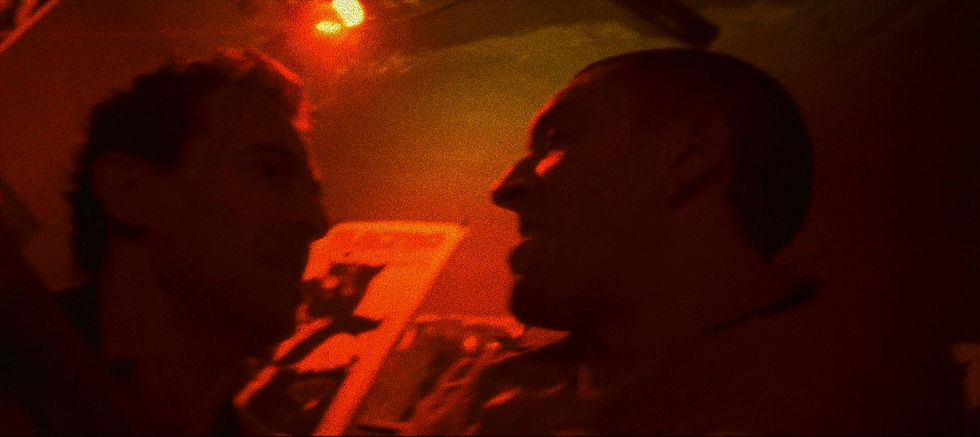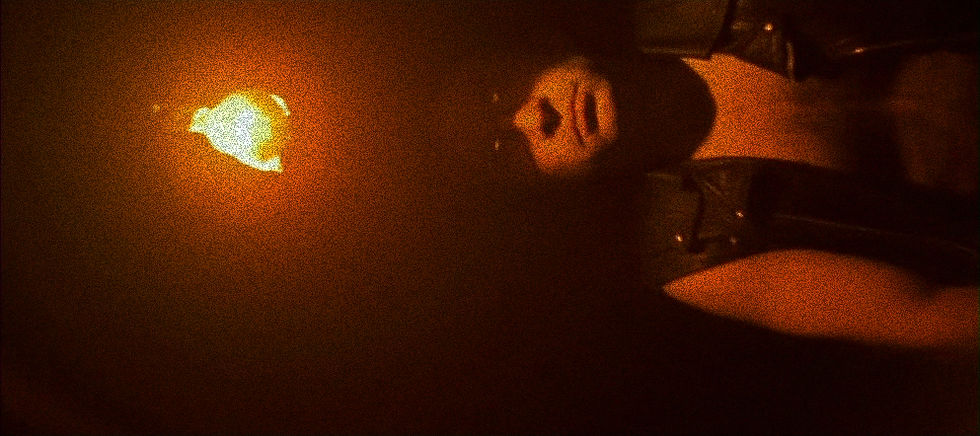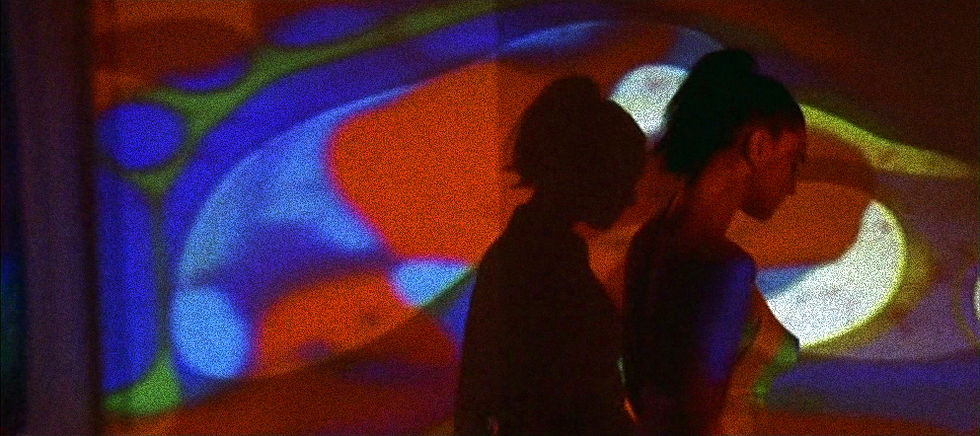Time Destroys Everything: The Legacy of Irréversible
- Luca Pelo
- Jun 5, 2024
- 9 min read
Updated: Jun 5, 2024
Cinema has always been a source of controversy. Boundary pushing films have long paved the way for new sub-genres and set new standards for what the medium can achieve. However some films don’t simply push the boundary, they cross it. For Argentine director Gaspar Noé, this is–and has always been–the end goal of his filmmaking, and never more apparently than in his 2002 psychosexual thriller, Irréversible. The film utilizes both its form and function equally to craft a uniquely nightmarish experience for its audience. It has been criticized for being pornographic, indulgent, and exploitative, but I argue that its unconventional structure, relentlessly cruel nature, and philosophical backbone are the very attributes that absolve it of these labels.

From the opening sequence it’s clear that the brutality of the film transcends its graphic violence. The cinematography is dynamic and nauseating, barrel-rolling and contorting before any action has even occurred– or so it seems. Irréversible, as the title suggests, is chronologically reversed, divided into fourteen episodic segments, each revealing the context for the scene before it, presenting the viewers with a mysterious tragedy, and asking them to gradually put together the broken pieces.
The chaotic camera work, however, is not a purely stylistic choice– Noé has channeled a hurricane of emotion into the opening scene, without yet revealing what emotions you’re actually supposed to be feeling. The answer is pure anger, an emotion that one might typically feel at the climax of an intense movie, not three minutes after the title sequence. In An Edgy Realism (Schaefer, 2015), the author describes the film’s initial cinematography as a truly “gyroscopic camera”; that which “appears to be as unchained as [Marcus, the protagonist’s] blind rage.” (p. 90) I would go even further to say that the camerawork embodies Marcus’ blind rage (and the disorienting, alarm-like synth: his cocaine-ridden heartbeat), as it is not a projection of what we should feel as an audience at all– Noé makes it very clear from the beginning that we are trespassing on someone else’s story, walking through the wrong door and seeing something we were not meant to see, something that has nothing to do with us. Of course, what we witness, positioned as bystanders, is Pierre, a protagonist, violently bashing in the head of an unidentified character with a fire extinguisher– and ironically, for a film whose camera is practically bouncing off the walls, unable to focus on a single subject, it just so happens to capture every frame of this unconscionable murder, leaving nothing to the imagination.

It’s reasonable to assume that this scene is around the time 250 audience members walked out of the film’s general screening at the Cannes Festival 2002. According to Schaefer, fire wardens had to administer oxygen to 20 of them. This was probably for the best, as the end result of Marcus’ anger nearly pales in comparison to the origin of it. As the segments progress (or rather, regress), the camera projects a semblance of normalcy, and we learn that Pierre and Marcus are retaliating in response to finding Marcus’ girlfriend, Alex, comatose and badly beaten, on a hospital stretcher. At this point, we have already seen what Noé is capable of showing on screen, and given the reverse nature of the narrative, we know we are about to be shown the event of Alex’s assault, likely in great detail. And yet somehow, we are still left unprepared for what reveals itself to be an 11-minute scene depicting Alex being raped and nearly beaten to death after witnessing the antagonist–La Tenia, or “the tapeworm”– abusing a prostitute in an empty subway station. Schaefer notes that during this scene, the “kinetic camera becomes suddenly and cruelly static” (p. 90), kept low and fixed with zero cuts or movement for the entirety of the assault. The result is paralyzing, with Fiona Morrow–who interviewed Noé about the film– citing it as “possibly the least exploitative on-screen rape I've ever seen.” She then describes a blink-and-you’ll-miss-it moment in which an out-of-focus pedestrian walks towards the scene of the crime and quickly hurries away. “This is what really disturbs us” she explains, “Not the rape itself, but the instinct to turn away”. In many ways, if there is one character in the film meant to represent (or critique) the audience, it is this faceless bystander, likely mirroring the very people walking out of the theatre in real time. One shouldn’t even have to watch the scene to realize that it’s an endurance test at best, and punishing at worst. To call the film pornographic for including this scene is problematic in and of itself.
To address these allegations, Schaefer summons a quotation from the great Roger Ebert: “It has been said that no matter what it pretends, pornography argues for what it shows. Irréversible is not pornography” (p 94). By Ebert’s definition, Irréversible is as far from pornographic as they come. Before the time the rape scene even occurs, we have already seen the frightening ramifications of it, and we are left to view the rest of the film as we see the characters devolve back into normal people, unaware of the horrors that we know lies ahead. These aren’t hunches, or predictions based on patterns and foreshadowings– we as an audience have already experienced the entire spectrum of pain alongside the characters, not afforded the luxury of implication or suggestion. This is an anomaly in cinema, and it is not until we see the characters laughing and kissing and dancing that we fully begin to understand what the title of the film really suggests: for Pierre, Marcus, and Alex, nothing will ever be the same– not just in a grand, cosmic sense, but in terms of every little moment of calm and happiness. We are forced to witness what was taken from them in the course of a few short hours, and that is, in many ways, more harrowing than the violence itself. As Schaefer points out, “what makes Irréversible important are the very things that repel most of the people who assail it”, citing its transgressive exploration of sex and violence, its gyroscopic camerawork and stroboscopic editing. However, arguably the most important component that he notes is “its against-the grain analysis of space, time, and destiny” (p. 89). As much as Noé is attacking bourgeois ignorance and existential numbness, he is also reframing it as something brief, blissful, rare, and ultimately unraveled by the relentless march of time; expedited by trauma.

Irreversible is often cited as a key component of the New French Extremity, a term coined by critic James Quandt to describe a turn of the century movement characterized by an art-house or unconventional approach towards themes and content usually associated with exploitation cinema or Hollywood genre films (Hagman, 2007). The movement is composed of provocateurs like Claire Denis, Michael Haneke, Gaspar Noé, and Pascal Laugier, and is known for its brutal depiction of violence and graphic sexuality. In some cases, New French Extremity films can be literally pornographic, as in the case of Baise-Moi (2000), which stars pornographic actresses and features unsimulated sexual acts.
The New French Extremity was birthed out of the implementation of exception culturelle, a 1993 French national protectionist policy that sought to preserve France’s cinematic identity by ensuring the funding of both high and low budget French productions, and encouraging the sustainment of a high artistic standard (Hagman, 2007). Of course if there is any subgenre that would need legislation to get funding, it would be the repulsive, critically reviled, and often outright hateful New French Extremity, designed to repel and divide audiences by nature. Of course, both exception culturelle and the subsequent New French Extremity were an act of rebellion against Hollywood’s globalization efforts– an attempt at industry monopolization and cultural dominance that we feel the effects of to this day. Extremist auteurs like Denis (Trouble Every Day, 2001) and Despentes (Baise Moi, 2000) took this rebellion a step further, satirizing and contorting Hollywood genre film tropes such as revenge thrillers and romances, and handling them like exploitation films. However, as Hagman emphasizes, “the relationship of French auteurist film-making to Hollywood is more complex than a simple oppositional one”, likening this mimicry to Jean-Paul Belmondo’s adoption of Humphrey Bogart’s signature lip rub in Godard’s Breathless (1961).
There is certainly a case to be made that the New French Extremity is something of a stripped down ode to Hollywood, simply expanding on America’s pioneering of ultra-violent cinema with films like Bonnie and Clyde (1967) and The Texas Chainsaw Massacre (1974), however, this is where Irreversible deviates from its kin. Where a typical revenge film revels in its own violence, with its entire narrative often serving the sole purpose of justifying a violent climax, the narrative structure of Irreversible critiques this, and saps the satisfaction out of the violence. Not only is this a sensible decision, it's an important one– one that causes us to rethink our relationship with violence in cinema. In this way, it criticizes the New French Extremity itself as much as it does Hollywood. After all, as transgressive as the films of this movement may have been at their inception, only so many can be produced until they cease to make waves anymore. As Hagman puts it, “the transgression [of NFE films] is already anticipated, and to some extent constituted by, the market, thus serving to drain the word 'transgressive' of its very meaning” (Hagman, 2007). After a certain point, the films of the New French Extremity are redundant, and if– like most of them– they fail to summon anything greater than discomfort and disgust, and bank on the same climactic satisfaction to engage viewers, then they are no better nor more profound than the Hollywood blockbusters that they mock. Irreversible obviously subverts this by “disengaging it from the temporal order and motivating structure of the narrative”, and in doing so, it has completely altered its genre (Hagman, 2007). What might have been an explosive revenge thriller becomes a poignant, cerebral tragedy– one that rewards its audience for looking inwards, not by cheap thrills. Noé himself confirms this assertion, citing the film as a sentimental tragedy about losing someone you love. “In a drama, dramatic things happen, and in a tragedy, they unfold. In a tragedy you cannot change events,” he explains, “you’ve already seen what’s going to happen next. So all you can ask is, ‘What happened before?’ ” (Brottman et al; 2003). This idea seems almost hamfisted given the overt amount of allusions to it in the film’s title, poster, structure, and marketing, but its complex, philosophical foundation in fatalism says otherwise.

Brottman argues that Irreversible applies an internal locus of control to the characters, and suggests that in this century, “we can no longer attribute violence and disaster to any cause outside the brutal nature of humanity itself” (p. 41). This places the blame on the characters’ inherently destructive tendencies rather than anything else. It's a deeply cynical point of view, and one that Noé is widely known for. This is only furthered by the film's early reveal that the man who was brutally murdered by Pierre in an attempt to avenge Alex’s attack was simply a look alike. Out of anger spurred by violence towards the innocent, Pierre savagely, and publicly, murdered an innocent. It's a twisted irony that Noé adds–very intentionally it seems– to highlight the fact that, on a cosmic level, the distinction really doesn’t matter. By that point in the night, fate had already set in. A string of events that would determine the rest of their lives; a self fulfilling prophecy of destruction. The victim’s face is an obscured, bloody mess with no form, and no identity, illuminated by the flashing red lights of the nightclub, just as Alex’s brutalized face had been illuminated by the flashing red lights of the ambulance just moments before, or as Marcus’ had been by the flashing red lights of the party, where he messed around with other women, unaware that in the same moment, his life would change forever.

In the final sequence, Noé throws one last punch. Alex stares at a pregnancy test and holds her belly as the camera pans upwards toward the heavens, past a poster of the star child from 2001: A Space Odyssey (1968), once again barrel rolling and contorting, but this time to Beehtoven’s Symphony No. 7. It twirls whimsically and leads us out of an open window to a grassy park, where Alex lies in leisure and reads, while children play around her. We are then taken yet again into a nauseating vortex, led into the open sky– the first time we see daylight in the entire film. Eventually, we can no longer distinguish if the camera is moving or not. All we see is the white of the sky, flickering progressively faster until it is a serious epilepsy risk, and nearly unbearable to look at, while Symphony No. 7 degenerates into a cacophony of white noise. Noé wants to make it very clear; chaos did not begin that fateful night. It was always there– a ubiquitous force of nature that we choose to filter out, transcending time and reason. We are thrown into the film in a fit of indecipherable chaos with no understanding of what it entails, and so it's only fitting that we leave the film staring into the same void, wishing we were as ignorant as before we had pressed play, but knowing that we never will be. As the white fades to black, four words briefly fill the screen: Le temps detruit tout– time destroys everything.
Works Cited
Schaefer, Jerome. An Edgy Realism : Film Theoretical Encounters with Dogme 95, New French Extremity, and the Shaky-Cam Horror Film, Cambridge Scholars Publisher, 2015. ProQuest Ebook Central, http://ebookcentral.proquest.com/lib/lewisclark/detail.action?docID=4534672.
Morrow, Fiona. "Film: I'm not the Antichrist; Gaspar Noe, whose film Irreversible (left) is about the brutal rape of a middle-class woman, has been accused of everything from fascism to misogyny. But, the director tells FIONA MORROW, it's the audience who are really sick, not him." Independent [London, England], 17 Jan. 2003, p. 10. Gale General OneFile, link.gale.com/apps/doc/A96547118/ITOF?u=lacc_legal&sid=ITOF&xid=a6197724
Hagman, Hampus. “‘Every Cannes Needs Its Scandal’: Between Art and Exploitation in Contemporary French Film.” Film International (16516826), vol. 5, no. 5, Sept. 2007, pp. 32–41. EBSCOhost, doi:10.1386/fiin.5.5.32.
Brottman, Mikita, and David Sterritt. “Irréversible.” Film Quarterly, vol. 57, no. 2, 2003, pp. 37–42. JSTOR, www.jstor.org/stable/10.1525/fq.2004.57.2.37. Accessed 5 May 2021.

Comments